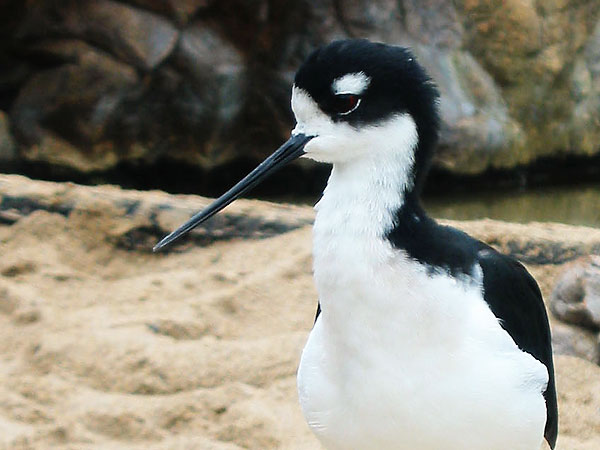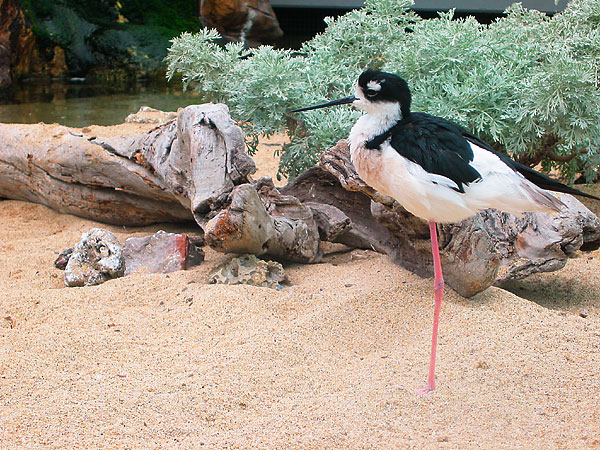Black-necked Stilt
Himantopus mexicanus
Black-necked Stilts are usually migratory birds, but there are some resident populations in coastal southern California and western Mexico. There is a very large resident population at San Francisco Bay where they mingle with resident American Avocets, Recurvirostra americana. There are smaller groups at the Bolsa Chica Ecological Reserve, Seal Beach National Wildlife Refuge, and the northern area of Upper Newport Bay. Living and nesting in flocks, they are gregarious, noisy, and aggressive birds.

One of our Black-necked Stilts in its exhibit at the Aquarium. Credit: Andrew Reitsma

One of our Black-necked Stilts in its exhibit at the Aquarium. Credit: Andrew Reitsma
SPECIES IN DETAIL
Black-necked Stilt
Himantopus mexicanus
CONSERVATION STATUS: Safe for Now
CLIMATE CHANGE: Not Applicable
At the Aquarium
Our black-necked stilts are named Oscar and Gigi. They live in the Shorebird Sanctuary exhibit outdoors on the second floor.
Geographic Distribution
Atlantic coast from Delaware south and Pacific coast from Oregon south to Peru and the Galapagos Islands, Central US as far inland as Idaho and Kansas, and Gulf of Mexico states. Most winter south of North America.
Habitat
Black-necked Stilts can be found in and around shallow brackish and freshwater estuaries and marshes, earthen flood control channels, marginal wetland areas, shallow lake-shores, coastal bays, prairie ponds, and flooded fields.
Physical Characteristics
Black-necked Stilts are very slender-bodied, long-necked, wading shorebirds with striking black and white plumage. Their dark bills are slender, long, and needle pointed. Their pink-to-red long legs are webbed between the middle and inner toes on each foot, enabling them to wade in muddy bottomed water. The upper body of males is glossy black and in females, blackish-brown. Their lower body, sides of neck, cheeks, and foreheads are white. The wings are dark above and below. There is a white spot over each eye and a white area over the bill. The iris of their eyes is crimson or carmine. In flight their body appears to be white.
Size
These birds are 33-41 cm (13-16 in) long. Their wingspan is 63-69 cm (25-27 in) and their legs are 20-25 cm (8-10 in) long. They weigh 140-167 gm (4.9 -5.9 oz).
Diet
These birds use both touch and visual strategies to find food. Very active when feeding, they eat a variety of small creatures, primarily aquatic invertebrates such as brine shrimp and crayfish and insects such as grasshoppers, brine flies, beetles, and dragonfly nymphs. Their diet also includes some small fishes, tadpoles, and reptiles. They peck in the mud or at the surface of the water to feed.
Reproduction
Black-necked Stilts are sexually mature at two to three years of age. They nest in loose colonies of as many as 50 bird pairs. Courtship consists of elaborate preening and bill dipping displays. The male pecks the ground and water alternately and then preens his breast feathers. The female stretches her body and neck while the male circles her, flicking water with his bill. After mating the pair cross bills and walk together for a short distance. Once paired, they stay together during the breeding season.
Nests vary from shallow depressions in the ground lined with vegetation or shell fragments to larger mounds of grassy vegetation, twigs, and debris built near water. If the water rises, they quickly add material to raise the height of the nest. Females lay 3-4 dark-spotted buff-colored eggs that are about 44 mm (1.7 in) long. Both parents incubate the eggs for 22-26 days and then care for the chicks.
Hatchlings are precocial. At birth their eyes are open, they are down covered, and they leave the nest about two hours after hatching. The down of the chicks is light brownish-gray with black spots. When adults give alarm calls, the chicks scatter and lay flat on the ground, their camouflage coloring blending in well with their surroundings. Chicks fledge in about 28-32 days.
Behavior
Gregarious and living in flocks, Black-necked Stilts are noisy, strongly territorial, and aggressive. They are fearless in defense of their nests. They fly to meet the intruder uttering their alarm calls that sound like kip-kip-kip-kip in a strident, sharp, shrill voice. They bob up and down by bending their knees and strike the surface of the water with their breast to make sharp splashes. They also run ashore and do a crippled-bird distraction display in which they act injured in order to lure predators away from the nest or chicks, and toward the adult bird.
These birds exhibit an anti-predator behavior called “The Popcorn Display”. Groups of adults circle a ground predator and hop side to side while flapping their wings and calling shrilly. They walk gracefully with long strides that quickly turn into almost a run.
Adaptation
The long bills of these stilts and their long legs with partially webbed feet are adapted for foraging in water. They have the longest legs in relation to their body of any living bird. The length enables them to wade up to their belly in deep water to pick at insects on or close to the water’s surface. Their beaks are also adapted for foraging in mud and sand. Foraging on land, they have to bend their legs in order for their bills to reach the ground.
Conservation
On the west coast, particularly in Southern California, loss of wetland breeding habitats has reduced the population while numbers and ranges in inland states are increasing. Migratory birds, Black-necked Stilts are protected under the International Migratory Bird Treaty.
The “Hawaiian” Stilt (H.mexicanus knudseni), a subspecies, is federally listed as endangered.
Special Notes
California’s Salton Sea is a last migratory stop along the Pacific Flyway for Black-necked Stilts as they head south. Here flocks of as many as 10,000 stilts stop to feed. The Sea’s increasing salinity and pollution of fish that are eaten by the stilts may have adverse effects on this migratory population.
SPECIES IN DETAIL | Print full entry
Black-necked Stilt
Himantopus mexicanus
CONSERVATION STATUS: Safe for Now
CLIMATE CHANGE: Not Applicable
Our black-necked stilts are named Oscar and Gigi. They live in the Shorebird Sanctuary exhibit outdoors on the second floor.
Atlantic coast from Delaware south and Pacific coast from Oregon south to Peru and the Galapagos Islands, Central US as far inland as Idaho and Kansas, and Gulf of Mexico states. Most winter south of North America.
Black-necked Stilts can be found in and around shallow brackish and freshwater estuaries and marshes, earthen flood control channels, marginal wetland areas, shallow lake-shores, coastal bays, prairie ponds, and flooded fields.
Black-necked Stilts are very slender-bodied, long-necked, wading shorebirds with striking black and white plumage. Their dark bills are slender, long, and needle pointed. Their pink-to-red long legs are webbed between the middle and inner toes on each foot, enabling them to wade in muddy bottomed water. The upper body of males is glossy black and in females, blackish-brown. Their lower body, sides of neck, cheeks, and foreheads are white. The wings are dark above and below. There is a white spot over each eye and a white area over the bill. The iris of their eyes is crimson or carmine. In flight their body appears to be white.
These birds are 33-41 cm (13-16 in) long. Their wingspan is 63-69 cm (25-27 in) and their legs are 20-25 cm (8-10 in) long. They weigh 140-167 gm (4.9 -5.9 oz).
These birds use both touch and visual strategies to find food. Very active when feeding, they eat a variety of small creatures, primarily aquatic invertebrates such as brine shrimp and crayfish and insects such as grasshoppers, brine flies, beetles, and dragonfly nymphs. Their diet also includes some small fishes, tadpoles, and reptiles. They peck in the mud or at the surface of the water to feed.
Black-necked Stilts are sexually mature at two to three years of age. They nest in loose colonies of as many as 50 bird pairs. Courtship consists of elaborate preening and bill dipping displays. The male pecks the ground and water alternately and then preens his breast feathers. The female stretches her body and neck while the male circles her, flicking water with his bill. After mating the pair cross bills and walk together for a short distance. Once paired, they stay together during the breeding season.
Nests vary from shallow depressions in the ground lined with vegetation or shell fragments to larger mounds of grassy vegetation, twigs, and debris built near water. If the water rises, they quickly add material to raise the height of the nest. Females lay 3-4 dark-spotted buff-colored eggs that are about 44 mm (1.7 in) long. Both parents incubate the eggs for 22-26 days and then care for the chicks.
Hatchlings are precocial. At birth their eyes are open, they are down covered, and they leave the nest about two hours after hatching. The down of the chicks is light brownish-gray with black spots. When adults give alarm calls, the chicks scatter and lay flat on the ground, their camouflage coloring blending in well with their surroundings. Chicks fledge in about 28-32 days.
Gregarious and living in flocks, Black-necked Stilts are noisy, strongly territorial, and aggressive. They are fearless in defense of their nests. They fly to meet the intruder uttering their alarm calls that sound like kip-kip-kip-kip in a strident, sharp, shrill voice. They bob up and down by bending their knees and strike the surface of the water with their breast to make sharp splashes. They also run ashore and do a crippled-bird distraction display in which they act injured in order to lure predators away from the nest or chicks, and toward the adult bird.
These birds exhibit an anti-predator behavior called “The Popcorn Display”. Groups of adults circle a ground predator and hop side to side while flapping their wings and calling shrilly. They walk gracefully with long strides that quickly turn into almost a run.
The long bills of these stilts and their long legs with partially webbed feet are adapted for foraging in water. They have the longest legs in relation to their body of any living bird. The length enables them to wade up to their belly in deep water to pick at insects on or close to the water’s surface. Their beaks are also adapted for foraging in mud and sand. Foraging on land, they have to bend their legs in order for their bills to reach the ground.
On the west coast, particularly in Southern California, loss of wetland breeding habitats has reduced the population while numbers and ranges in inland states are increasing. Migratory birds, Black-necked Stilts are protected under the International Migratory Bird Treaty.
The “Hawaiian” Stilt (H.mexicanus knudseni), a subspecies, is federally listed as endangered.
California’s Salton Sea is a last migratory stop along the Pacific Flyway for Black-necked Stilts as they head south. Here flocks of as many as 10,000 stilts stop to feed. The Sea’s increasing salinity and pollution of fish that are eaten by the stilts may have adverse effects on this migratory population.

